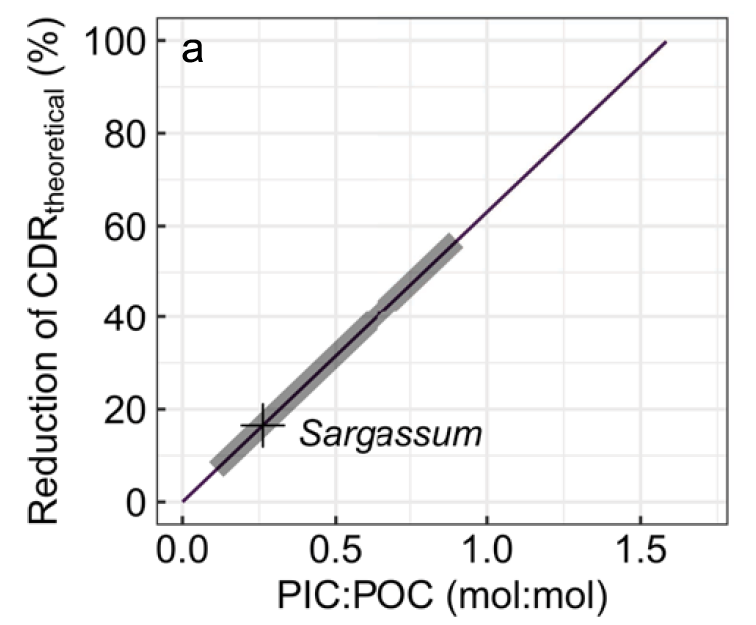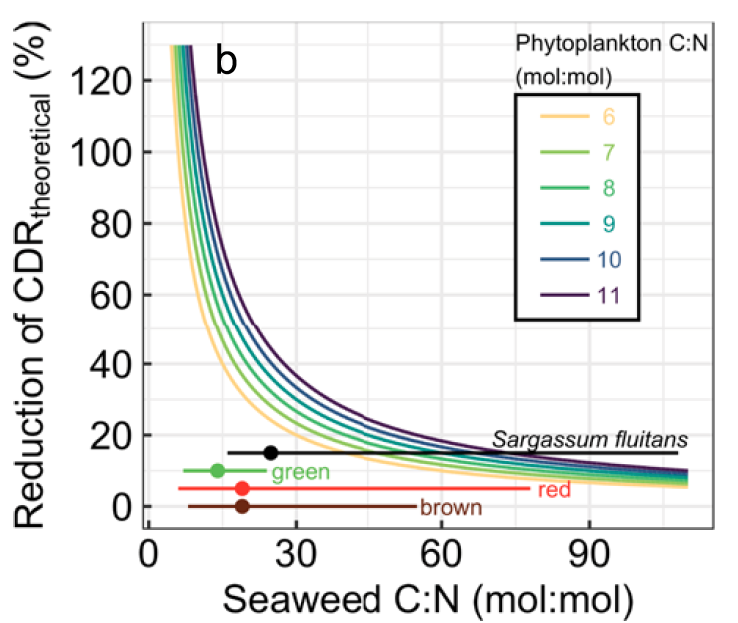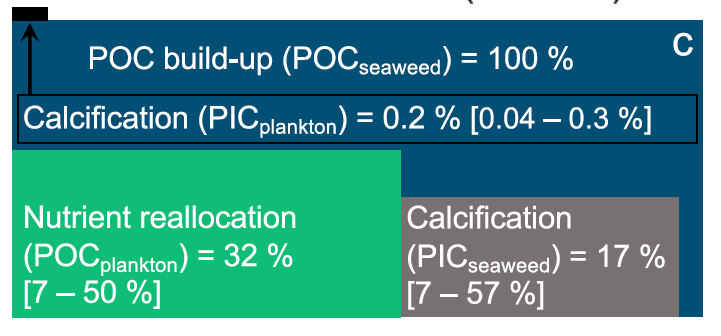We utilised the Great Atlantic #Sargassum Belt to test if large-scale offshore #seaweed farming ( #OceanAfforestation) could be an effective method for atmospheric CO2 removal.
Conclusion: rather not.
Thread (1/n)
@IMASUTAS https://www.nature.com/articles/s41467-021-22837-2">https://www.nature.com/articles/...
Conclusion: rather not.
Thread (1/n)
@IMASUTAS https://www.nature.com/articles/s41467-021-22837-2">https://www.nature.com/articles/...
2/n
Since 2011 the pelagic seaweed Sargassum has extended its occurrence mainly from the Sargasso Sea to large parts of the (sub)tropical Atlantic. In 2018 their net carbon build-up was 0.8 Million tons and they covered up to 6000 km2. https://science.sciencemag.org/content/365/6448/83.abstract">https://science.sciencemag.org/content/3...
Since 2011 the pelagic seaweed Sargassum has extended its occurrence mainly from the Sargasso Sea to large parts of the (sub)tropical Atlantic. In 2018 their net carbon build-up was 0.8 Million tons and they covered up to 6000 km2. https://science.sciencemag.org/content/365/6448/83.abstract">https://science.sciencemag.org/content/3...
3/n
So, can we assume that these 0.8 Million tons of carbon would be the CO2 removal of Sargassum farming at the size of the Great Atlantic Sargassum Belt?
No, this number is modified by other feedbacks, such as calcification and nutrient reallocation.
So, can we assume that these 0.8 Million tons of carbon would be the CO2 removal of Sargassum farming at the size of the Great Atlantic Sargassum Belt?
No, this number is modified by other feedbacks, such as calcification and nutrient reallocation.
4/n
Calcification reduces seawater #alkalinity, thereby reducing the capacity of seawater to take up CO2. Seaweeds like Sargassum do not calcify but provide habitat for encrusting calcifiers, which can be seen on these pics by @janosam https://twitter.com/janosam/status/1389285576420040709?s=03">https://twitter.com/janosam/s...
Calcification reduces seawater #alkalinity, thereby reducing the capacity of seawater to take up CO2. Seaweeds like Sargassum do not calcify but provide habitat for encrusting calcifiers, which can be seen on these pics by @janosam https://twitter.com/janosam/status/1389285576420040709?s=03">https://twitter.com/janosam/s...
5/n
Based on the amount of calcium carbonate associated with pelagic Sargassum from the Sargasso Sea we estimated that the CO2 discount due to the #calcification is between 7-57%. i.e. negligible to substantial.
Based on the amount of calcium carbonate associated with pelagic Sargassum from the Sargasso Sea we estimated that the CO2 discount due to the #calcification is between 7-57%. i.e. negligible to substantial.
6/n
When seaweeds consume nutrients for C-fixation then these nutrients become unavailable for #phytoplankton. Thus, seaweed farming needs to subtract the carbon fixation by phytoplankton that would have been possible with the reallocated nutrients.
When seaweeds consume nutrients for C-fixation then these nutrients become unavailable for #phytoplankton. Thus, seaweed farming needs to subtract the carbon fixation by phytoplankton that would have been possible with the reallocated nutrients.
7/n
If seaweeds can sequester more carbon per nutrient than phytoplankton then there is a net benefit of seaweed farming on C-fixation. This is generally the case for Sargassum and most seaweeds but nutrient reallocation still constitutes a CDR discount between 7-50%
If seaweeds can sequester more carbon per nutrient than phytoplankton then there is a net benefit of seaweed farming on C-fixation. This is generally the case for Sargassum and most seaweeds but nutrient reallocation still constitutes a CDR discount between 7-50%
8/n
Nutrient re-allocation from phytoplankton to Sargassum also reduces calcification by phytoplankton, which then should be accounted as a C-sink indirectly established by Sargassum. However, this “bonus” is probably small (i.e. <1%).
Nutrient re-allocation from phytoplankton to Sargassum also reduces calcification by phytoplankton, which then should be accounted as a C-sink indirectly established by Sargassum. However, this “bonus” is probably small (i.e. <1%).
9/n
Altogether the discounts to C-fixation by Sargassum due to calcification and nutrient reallocation are roughly between 20-100%. Accounting for the exact number is difficult but necessary for seaweed carbon farming.
Altogether the discounts to C-fixation by Sargassum due to calcification and nutrient reallocation are roughly between 20-100%. Accounting for the exact number is difficult but necessary for seaweed carbon farming.
10/n
Sargassum also releases dissolved organic carbon ( #DOC), which may be considered an additional C-sink. However, DOC release needs to be quantified and distinguished from (and evaluated against) DOC released by plankton. Not possible atm. https://agupubs.onlinelibrary.wiley.com/doi/full/10.1029/2019GB006225">https://agupubs.onlinelibrary.wiley.com/doi/full/...
Sargassum also releases dissolved organic carbon ( #DOC), which may be considered an additional C-sink. However, DOC release needs to be quantified and distinguished from (and evaluated against) DOC released by plankton. Not possible atm. https://agupubs.onlinelibrary.wiley.com/doi/full/10.1029/2019GB006225">https://agupubs.onlinelibrary.wiley.com/doi/full/...
11/n
After CO2 fixation, atmospheric CO2 must be absorbed to replenish the seawater CO2 deficit. Thanks to research by @DanJonesOcean et al we know that this often takes longer than the CO2-deficient water is in contact with the atmosphere. https://agupubs.onlinelibrary.wiley.com/doi/full/10.1002/2014GB004813">https://agupubs.onlinelibrary.wiley.com/doi/full/...
After CO2 fixation, atmospheric CO2 must be absorbed to replenish the seawater CO2 deficit. Thanks to research by @DanJonesOcean et al we know that this often takes longer than the CO2-deficient water is in contact with the atmosphere. https://agupubs.onlinelibrary.wiley.com/doi/full/10.1002/2014GB004813">https://agupubs.onlinelibrary.wiley.com/doi/full/...
12/n
For the GASB region this CO2 influx may take 2.5–18 times longer than the CO2-deficient seawater remains in contact with the atmosphere. Thus, we cannot simply assume that seawater CO2 fixation = atmospheric CO2 removal.
For the GASB region this CO2 influx may take 2.5–18 times longer than the CO2-deficient seawater remains in contact with the atmosphere. Thus, we cannot simply assume that seawater CO2 fixation = atmospheric CO2 removal.
13/n
For “permanent” sequestration, carbon fixed in seaweeds must be stored e.g. on the deep seafloor. Storage permanence varies from ~700 (Atlantic) to ~1400 years (Pacific). This is not infinite but generally longer than e.g. for terrestrial forests. https://agupubs.onlinelibrary.wiley.com/doi/full/10.1029/2018JC014716">https://agupubs.onlinelibrary.wiley.com/doi/full/...
For “permanent” sequestration, carbon fixed in seaweeds must be stored e.g. on the deep seafloor. Storage permanence varies from ~700 (Atlantic) to ~1400 years (Pacific). This is not infinite but generally longer than e.g. for terrestrial forests. https://agupubs.onlinelibrary.wiley.com/doi/full/10.1029/2018JC014716">https://agupubs.onlinelibrary.wiley.com/doi/full/...
14/n
Seaweeds would not only affect the C-cycle but also seawater albedo because seaweeds likely enhance the reflection of sunlight. This could have a larger effect on radiative forcing than CO2 removal. BUT things are much more complicated through indirect albedo effects
#SRM
Seaweeds would not only affect the C-cycle but also seawater albedo because seaweeds likely enhance the reflection of sunlight. This could have a larger effect on radiative forcing than CO2 removal. BUT things are much more complicated through indirect albedo effects
#SRM
15/n
Overall, establishing #OceanAfforestation as a net CO2 sink takes more than generating seaweed biomass. There are so many physical/biogeochemical processes involved, the complexity of which will make it very difficult to evaluate the net climatic effect of seaweed farming.
Overall, establishing #OceanAfforestation as a net CO2 sink takes more than generating seaweed biomass. There are so many physical/biogeochemical processes involved, the complexity of which will make it very difficult to evaluate the net climatic effect of seaweed farming.
16/n
After having done this assessment we wonder “if the complexity associated with marine biota [e.g. Ocean Afforestation] may provide a compelling argument to focus [future R&D efforts] on bottom-up engineered and better understood abiotic [CO2 removal] methods.”
After having done this assessment we wonder “if the complexity associated with marine biota [e.g. Ocean Afforestation] may provide a compelling argument to focus [future R&D efforts] on bottom-up engineered and better understood abiotic [CO2 removal] methods.”
17/n
We thank many scientists who shared data, insights, or pictures. (Chuanmin Hu, Mengqiu Wang, @DanJonesOcean, Takamitsu Ito, Yohei Takano, Wei-Ching Hsu, @Jens_D_Mueller, Martin Jung, Andrew Lenton)
I also want to highlight some key papers to acknowledge their importance.
We thank many scientists who shared data, insights, or pictures. (Chuanmin Hu, Mengqiu Wang, @DanJonesOcean, Takamitsu Ito, Yohei Takano, Wei-Ching Hsu, @Jens_D_Mueller, Martin Jung, Andrew Lenton)
I also want to highlight some key papers to acknowledge their importance.
Data in this paper from Wang et al. was used many calculations. Our study would not have been possible without it. https://agupubs.onlinelibrary.wiley.com/doi/full/10.1029/2018GL078858">https://agupubs.onlinelibrary.wiley.com/doi/full/...
This paper by @James1Orr and Sarmiento contains early modelling work on OceanAfforestation (already in 1992) They also address the important problem of nutrient reallocation. https://link.springer.com/article/10.1007/BF00477113">https://link.springer.com/article/1...
The work by Pestana was important to assess how much CaCO3 is associated with Sargassum.
https://doi.org/10.1306/212F865C-2B24-11D7-8648000102C1865D
The">https://doi.org/10.1306/2... work by Frankignoulle et al is key for any sort of marine CO2 budgeting. https://doi.org/10.4319/lo.1994.39.2.0458">https://doi.org/10.4319/l...
https://doi.org/10.1306/212F865C-2B24-11D7-8648000102C1865D
The">https://doi.org/10.1306/2... work by Frankignoulle et al is key for any sort of marine CO2 budgeting. https://doi.org/10.4319/lo.1994.39.2.0458">https://doi.org/10.4319/l...
The study by Fogarty et al helped us to understand how seaweeds affect albedo.
https://doi.org/10.1002/2017JC013378
The">https://doi.org/10.1002/2... study by Kirschbaum et al provided the blue print for the albedo calculation.
https://bg.copernicus.org/articles/8/3687/2011/">https://bg.copernicus.org/articles/...
https://doi.org/10.1002/2017JC013378
The">https://doi.org/10.1002/2... study by Kirschbaum et al provided the blue print for the albedo calculation.
https://bg.copernicus.org/articles/8/3687/2011/">https://bg.copernicus.org/articles/...
The perspective by @DrRobBellamy and @Oliver_Geden was essential to contextualize what it takes to implement “successful” CO2 removal https://www.nature.com/articles/s41561-019-0475-7">https://www.nature.com/articles/...

 Read on Twitter
Read on Twitter





